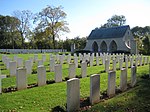Colleville-Montgomery

Colleville-Montgomery (French pronunciation: [kɔlvil mɔ̃ɡɔmʁi] ; formerly Colleville-sur-Orne) is a commune in the Calvados department in the Normandy region in northern France. It was known as Colleville-sur-Orne until 13 June 1946 to distinguish it from another town in the department, also in a coastal location, Colleville-sur-Mer. The new name honoured Field Marshal Bernard Montgomery, the senior-ranking British military commander who commanded the invasion of Normandy on 6 June 1944. There are two neighbouring towns in Calvados called Sainte-Foy-de-Montgommery and Saint-Germain-de-Montgommery, but they are named for Montgomery's family ancestors. They were part of William the Conqueror's invading army in 1066 and settled in England. The town was featured in the 1962 film, The Longest Day, detailing the French Resistance and their efforts on D-Day.
Excerpt from the Wikipedia article Colleville-Montgomery (License: CC BY-SA 3.0, Authors, Images).Colleville-Montgomery
Avenue du Becquet, Caen
Geographical coordinates (GPS) Address Nearby Places Show on map
Geographical coordinates (GPS)
| Latitude | Longitude |
|---|---|
| N 49.2833 ° | E -0.3 ° |
Address
Avenue du Becquet 16
14880 Caen
Normandy, France
Open on Google Maps










